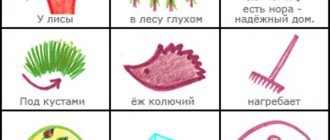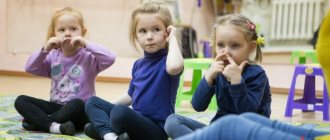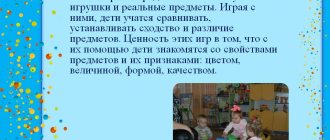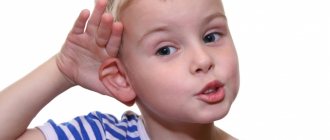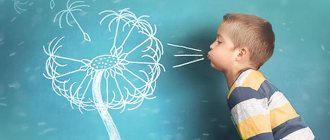In our time of technical breakthrough, a key place is given to the development of human creative abilities. Executive work is transferred to machines and automatic machines, the role of the author belongs to a person of the 21st century - a person with a rich imagination who knows how to find non-standard solutions. The formation of creative abilities begins in childhood, in preschool age. Therefore, diagnosing the imagination of a preschooler occupies a separate place in the education and development program in kindergarten.
Psychological methods for diagnosing the imagination of preschool children
Margarita Chernykhovskaya
Psychological methods for diagnosing the imagination of preschool children
The question of diagnostic methods and criteria for assessing children's imagination is raised in the works of many researchers. Experimental studies of children's imagination and creativity in modern psychology are based primarily on the method of quantitative assessments of the results of specially designed tests.
The methodological basis of most of these works is the theory of creative intelligence, developed in the 50s by J. Guilford, P. Torrance and their followers. Its essence is that, on the basis of factor analysis, individual components of creative thinking were identified (creativity factors that characterize forms of productive activity: flexibility, sophistication, originality, fluency. Based on this theory, tests were created in which these factors are an indicator of creative child's abilities.
To determine the level of development of creative processes, tasks such as constructing an object from these materials are proposed; finding different classification options for sets of objects , figures and letters; finishing an unfinished drawing; compiling a large number of drawings from given elements; coming up with different ways to use objects ; completing a sentence in various ways; coming up with possible consequences of extraordinary events; coming up with titles for a given picture or story; finding commonality between given objects or phenomena; asking questions about one picture; improvement of a given subject, etc.
At the same time, as we see, some of the tasks are clearly aimed at diagnosing creative thinking (for example, classification of sets of objects , figures, and some are aimed at the imagination (for example, completing drawings of figures)
. The specifics of these processes were practically not highlighted in these studies.
It seems to us, following O. M. Dyachenko, that the most adequate criterion for analyzing the main trends in the development of imagination is such a criterion as “originality”
Originality reflects the degree of individualization in the performance of creative tasks. But it is precisely this parameter that causes the greatest number of objections . Thus, S. Mednik and M. Mednik write that “originality is perhaps the easiest reaction that people are capable of. It is much more difficult to be a conventionalist than to be an originalist. For example, to the question of what the sum of 4+4 is equal to, one can answer 1367854. This is extremely original, because hardly anyone in the whole world has given a similar answer before. However, such a response cannot be called creative.”
O. M. Dyachenko proposes, along with the criterion of originality, to use the criterion of the direction of imagination . The fluence parameter reflects the contradiction between the instability, dynamism of imagination and the need to subordinate these images to the fulfillment of the assigned task, to direct them to the creation of a creative product, that is, it is the productivity, the direction of the imagination - not the spontaneity of emerging images, but their subordination to the assigned task. The flexibility parameter reflects the contradictions, on the one hand, between the actually perceived object and the meaning the child puts into it, and on the other hand, between the images of the imagination and the means for their implementation in each type of activity. Originality, combined with fluency and flexibility, can express the real novelty of imaginative , the novelty of the approach to the task. The use of these parameters becomes adequate for assessing the level of development of the creative components of a child’s productive imagination when analyzing the results of performing special tasks.
Methodology “Completing Figures”
.
Developed by O. M. Dyachenko, it is a variant of the E method . P. Torrens, is aimed at determining the level of development of imagination , the ability to create original images.
The material used is one (of two proposed)
a set of cards, on each of which one figure of an indeterminate shape is drawn. There are 10 cards in total in each set.
2 equivalent sets of such figures have been developed.
During the first examination, one of these kits is offered; another kit can be used during the second examination or after a year.
(KOR) was taken as the main quantitative indicator for assessing the level of success in completing tasks.
: Number of non-repeating images.
This is a complex indicator that records such parameters as fluency (the number of correct answers corresponding to the task, flexibility (the number of different categories of answers, that is, the variability of answers in one child) and originality (the frequency of the answer in a group
of children ) .
Along with the quantitative processing of the results, a qualitative description of the levels of task completion was carried out. The originality coefficient was correlated with one of the six main types of solving an imagination , in accordance with the “complexity”
O. M. Dyachenko, which made it possible to reveal the characteristics of children's
imagination , which ensures one or another level of fulfillment of creative tasks.
Methodology “Writing a fairy tale”
O. M. Dyachenko.
This technique was used to identify the level of development of creative imagination . The children were offered the following instructions: “Create your own fairy tale that you have never heard, no one told you.”
Then the child's composition was recorded in detail. When assessing essays, the child was given 0 points if he refused the task or retold a familiar fairy tale; if a child retold a familiar fairy tale, but made some modifications, then he received 1 point; If the child was based on some well-known fairy tales, but changed them significantly, he was given 2 points. Such changes could concern the characters of a fairy tale while maintaining the general plot (for example, a fairy tale is not about three little pigs, but about three bunnies)
or changes in the plot, but with the preservation of the characters
(a fairy tale about a wolf and a hare who perform some new actions)
. At the same time, the story as a whole is schematic, without details. For a fairy tale composed in the same way (with a score of 2 points, but expanded and detailed), the child received 3 points.
A fairy tale about characters invented by the child himself, who also performed actions invented by him, was scored 4 points. The fairy tale was created completely independently, but it was schematic. And finally, when a child composed a fairy tale independently, and the presentation was detailed and detailed, the author was given 5 points.
To study the cognitive activity “Wish Tree” technique is used.
V. S. Yurkevich.
Pictures and verbal situations are used as stimulus material. Children are asked to answer 6 problematic questions. The answer time for each question is from 4 to 6 minutes. From the answers, answers of a cognitive nature are selected. Quantitative and qualitative analysis is possible.
High level of cognitive need – 9 answers and above. Children are characterized by a desire to penetrate into the cause-and-effect relationships of phenomena, and an exploratory interest in the world is clearly manifested .
Average level – from 3 to 8 answers. There is a need for knowledge, but only specific information, and rather superficial information at that, is attracted.
Low level – 2 or fewer answers. Children are satisfied with monosyllabic information, for example, they are interested in the reality of a fairy tale, legend, etc. they once heard.
All these judgments are cognitive in nature, but differ in different levels of complexity.
"How to save a bunny"
V. T. Kudryavtseva.
the methodology to study the creative initiative of children , the ability to generate (search for)
supra-situational
(creative)
solutions, and allowed us to assess the ability to transform a choice task into a transformation task as a manifestation of creative supra-situational
(initiative)
.
Instructions: “Meet this bunny. One day such a story happened to him. The bunny decided to sail on a boat and sailed far, far from the shore. And then suddenly a storm began, huge waves appeared, and the bunny began to drown. Only you and I can help the bunny. We have several things for this. Here you go - get acquainted - a small wooden stick, a toy plate, a bucket, a deflated balloon, a sheet of blank paper. You are invited to choose from them those with which you can save the bunny.”
After the child has made a choice of items , he is asked to justify why.
Children's answers were compared with three main types of solutions to a given situation, identified by the author. Three main types of children's decisions.
1 type Children chose a possible means of salvation, trying to use alternative objects in ready-made form, transfer them to a new situation without any “adjustment”
(with a stick, to pick up a bunny)
.
Type 2 Children transform an object into a form of symbolic substitution (the stick appeared as a “substitute”
logs or a boat where it was proposed to put the bunny).
Type 3 The children had an attitude toward transforming subject material. The original choice task was independently rethought (problematized)
them and turned into a task of transformation.
(Inflate a balloon, make a paper boat out of a sheet)
.
According to the instructions, the child was asked to choose, and not to transform at all. The experimenter deliberately avoided the words “transform”
,
“remake”
, carriers of
the “transformational initiative”
.
We also took into account the levels of children's responses when solving problems .
Five levels of children’s when solving problems involving supra-situationalism (initiative)
.
Level 1. Refusal to choose. Doesn't accept the task (I don't know)
or claims that the problem cannot be solved, that is, he does not see in the proposed material a means for solving it.
Level 2. A simple situational solution. The child is not out of bounds
a simple choice, trying to use objects in finished form, mechanically transfer their external empirical properties to a new situation. The same level includes answers of the so-called arbitrary type, when children believe, for example, that one of the objects is magical or fairy-tale and therefore can do what they want; children mechanically remove the problem instead of solving it. In this case, the actions of the object are independent of its specific properties.
Level 3. Solutions with elements of simple symbolism. The child uses an element of magic and fabulousness, but at the same time takes into account the specifics of the subject.
Level 4. Trans-situational solutions. Children a focus on transforming available object material. They independently and proactively transform the initial task of choice into a task of transformation. This type of solution is associated with a holistic transformation of the situation.
Level 5. Complex supra-situational decisions. The child does not limit himself to transforming an object, but goes further: he additionally transforms the object or builds an integral situation by transforming several objects .
"Draw something" method
This diagnostic and research of creative imagination is offered by R.S. Nemov.
The preschooler receives a sheet of paper and markers or pencils. He is offered to draw whatever he wants.
It takes about five minutes to complete the task.
To assess the quality of a drawing, rely on the following indicators:
10 points: a preschooler, in the time allotted to him, comes up with and draws something unusual, which indicates his good imagination and vivid imagination. The child carefully works out the details of the picture.
8-9 points: the preschooler comes up with a colorful and original picture and does a good job of working out the details in it.
5 – 7 points: the preschooler comes up with a picture that is not new in itself, but includes some creative element. The audience experiences certain emotional impressions.
3-4 points: a preschooler draws something very simple, in which there is little trace of imagination. The details are poorly done.
0-2 points: the preschooler does not have time to come up with anything; only abstract lines and strokes are visible in the drawing.
The following levels of imagination are obtained:
The results of the study of creative imagination using E. Torrent’s method are presented in Table 1.
Table 1
Results of the study of creative imagination using the method of E. Torrent at the ascertaining stage of the experiment
| group | high level | average level | low level | |||
| quantity | % | quantity | % | quantity | % | |
| experimental group | 2 | 13,3 | 2 | 13,3 | 11 | 73,3 |
| control group | 1 | 6,7 | 4 | 26,7 | 10 | 66,7 |
As the results of a study of creative imagination using the E. Torrent method show, a high level was shown by 1 test subject of the control group - 6.7% and 2 test subjects of the experimental group - 13.3%. Over a certain period of time, the children came up with and drew something original, unusual, testifying to their extraordinary imagination and rich creative imagination.
The average level was shown by 4 subjects in the control group - 26.7% and 2 subjects in the experimental group - 13.3%. The children drew something that, in general, is not new, but contains clear elements of creative imagination. The details and images of the drawing are worked out moderately.
A low level was shown by 10 subjects in the control group - 66.7% and 11 subjects in the experimental group - 73.3%. The children were unable to come up with anything in the allotted time and only drew individual strokes and lines.
The results of the study of creative imagination using the “Draw Something” method by R.S. Nemov are presented in Table 2.
table 2
Results of the study using the “Draw something” method by R.S. Nemov at the ascertaining stage of the experiment
| group | high level | average level | low level | |||
| quantity | % | quantity | % | quantity | % | |
| experimental group | 1 | 6,7 | 3 | 20,0 | 11 | 73,3 |
| control group | 1 | 6,7 | 6 | 40,0 | 8 | 53,3 |
As the results of the study using the “Draw Something” method by R.S. Nemov show, a high level of creative imagination was shown by 1 subject of the control group - 6.7% and 1 subject of the experimental group - 6.7%. The children quickly came up with their own ideas, in which the originality of the answers was noted.
The average level was shown by 6 subjects of the control group - 40% and 3 subjects of the experimental group - 20%. It took the children a long time to come up with ideas; their answers contained elements of originality based on familiar situations.
A low level was shown by 8 subjects in the control group - 53.3% and 11 adolescents in the experimental group - 73.3%. The children couldn't come up with anything.
The results of the ascertaining stage of the experiment are presented in Table 3.
Table 3
Results of the study of creative imagination at the ascertaining stage of the experiment, in %
| criterion | structure of the product of imagination | detailing of imagination images | originality of products of imagination | ||||||
| level | VU | SU | WELL | VU | SU | WELL | VU | SU | WELL |
| Experimental group | 13,3 | 13,3 | 73,3 | 6,7 | 20 | 73,3 | 0 | 33,3 | 66,7 |
| Control group | 6,7 | 26,7 | 66,7 | 6,7 | 40 | 53,3 | 6,7 | 53,3 | 40 |
As the results of the study conducted at the ascertaining stage of the experiment show, 73.3% of preschool children in the experimental group and 66.7% of preschool children in the control group have a low level of creative imagination.
When drawing, children do not have time to come up with anything; only abstract lines and strokes are visible in the drawing. Or they draw something very simple in which there is little trace of imagination. The details are poorly done. Children are not able to create new interesting images. Most often, ideas are taken from a model or under the guidance of an adult.
Stages of formation of creative imagination
Stimulating preparatory stage.
The task of this stage is to encourage preschoolers to show creativity and imagination, to free themselves from emotional clamps and certain stereotypes.
At this stage, the first seven lessons were devoted to immersing children in the creative process. To do this, we demonstrated to preschoolers what possibilities exist for creating new images using different techniques using different materials, detailing certain images.
Training stage.
We have developed a set of game activities to develop creative imagination in older preschoolers. The objectives of this work were:
- formation of the need for self-expression;
- teaching older preschoolers the main techniques for producing new images;
- formation of originality and variability of plans.
In these classes, we developed preschoolers’ ability to create images and formed their creative imagination. During classes we used different types of activities and tasks to develop creative imagination.
The final stage.
It allows preschoolers to consolidate the skills they have already developed in producing original images, develop their emotional sphere, and try to convey to them a sense of freedom in self-expression.
Classes were usually structured according to the following structure:
- mood;
- actualization of sensations;
- individual work;
- verbalization.

